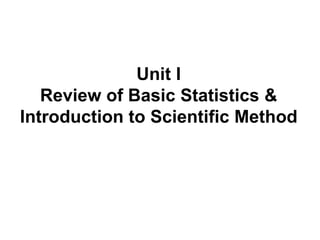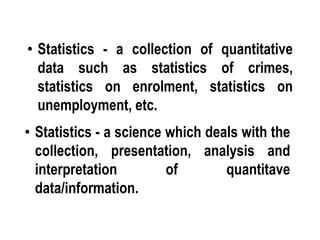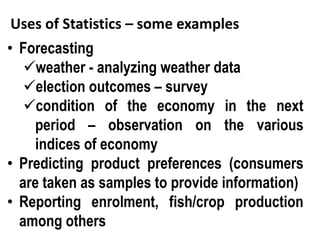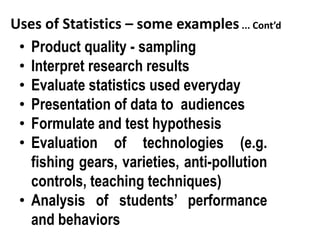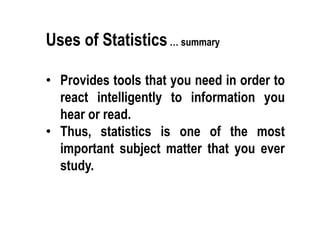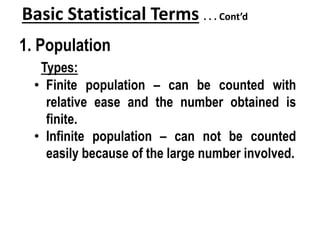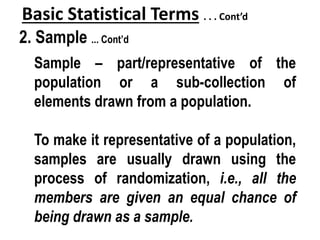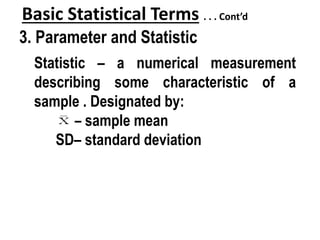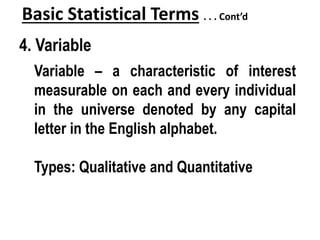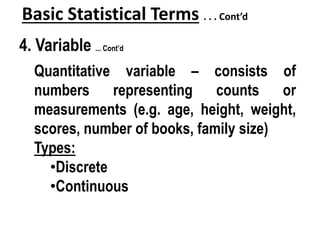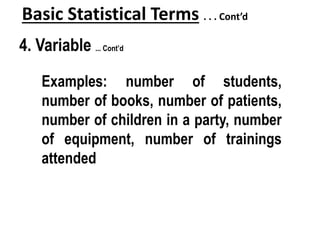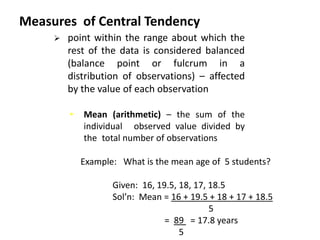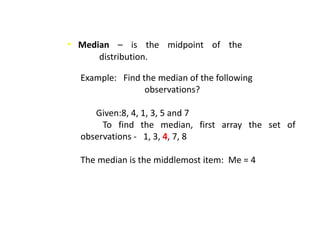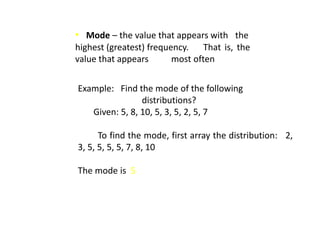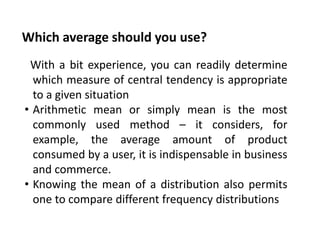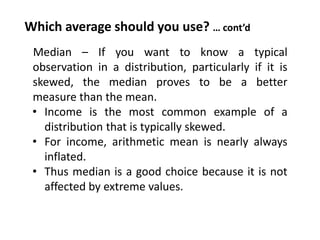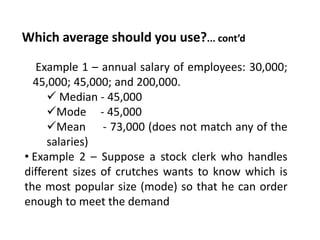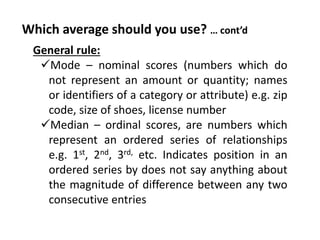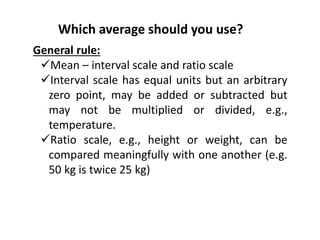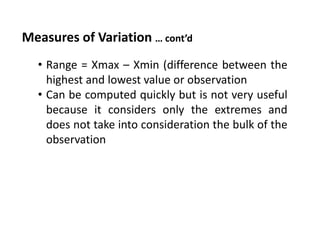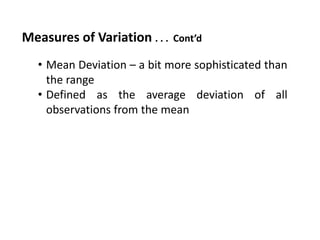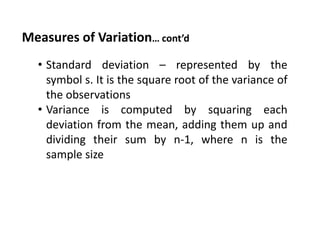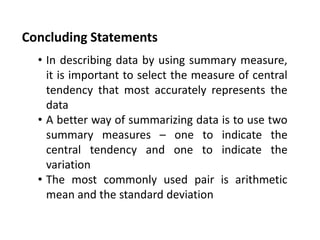Topic-1-Review-of-Basic-Statistics.pptx
- 1. Unit I Review of Basic Statistics & Introduction to Scientific Method
- 2. Statistical Terms Statistics The word statistics is derived from the Latin word status meaning “state”. The word statistics has two basic meanings: • we use this word when referring to actual numbers derived from data • We use statistics as a method of analysis
- 3. • Statistics - a collection of quantitative data such as statistics of crimes, statistics on enrolment, statistics on unemployment, etc. • Statistics - a science which deals with the collection, presentation, analysis and interpretation of quantitave data/information.
- 4. Uses of Statistics Statistics involves much more than the simple collection, tabulation and summarizing of data. It is also a tool that helps us develop meaningful conclusions that go beyond the original data.
- 5. Uses of Statistics – some examples • Forecasting weather - analyzing weather data election outcomes – survey condition of the economy in the next period – observation on the various indices of economy • Predicting product preferences (consumers are taken as samples to provide information) • Reporting enrolment, fish/crop production among others
- 6. Uses of Statistics – some examples ... Cont’d • Product quality - sampling • Interpret research results • Evaluate statistics used everyday • Presentation of data to audiences • Formulate and test hypothesis • Evaluation of technologies (e.g. fishing gears, varieties, anti-pollution controls, teaching techniques) • Analysis of students’ performance and behaviors
- 7. Uses of Statistics… summary • Provides tools that you need in order to react intelligently to information you hear or read. • Thus, statistics is one of the most important subject matter that you ever study.
- 8. Basic Statistical Terms . . . Cont’d 1. Population Types: • Finite population – can be counted with relative ease and the number obtained is finite. • Infinite population – can not be counted easily because of the large number involved.
- 9. Basic Statistical Terms . . . Cont’d 2. Sample Is it always possible to gather data from the entire population? Actually it is not always possible and it is even impractical to gather data from a large population. Researchers resort to studying a part of a population called sample.
- 10. Basic Statistical Terms . . . Cont’d 2. Sample ... Cont’d Sample – part/representative of the population or a sub-collection of elements drawn from a population. To make it representative of a population, samples are usually drawn using the process of randomization, i.e., all the members are given an equal chance of being drawn as a sample.
- 11. Basic Statistical Terms . . . Cont’d 3. Parameter and Statistic Parameter – a numerical measurement describing some characteristic of a population (data obtained from a population). Designated by: µ (mu) – population mean σ (sigma) – standard deviation
- 12. Basic Statistical Terms . . . Cont’d 3. Parameter and Statistic Statistic – a numerical measurement describing some characteristic of a sample . Designated by: – sample mean SD– standard deviation
- 13. Basic Statistical Terms . . . Cont’d 4. Variable Variable – a characteristic of interest measurable on each and every individual in the universe denoted by any capital letter in the English alphabet. Types: Qualitative and Quantitative
- 14. Basic Statistical Terms . . . Cont’d 4. Variable ... Cont’d Qualitative variable – consists of categories or attributes, which have non- numerical characteristics Examples: classification, year level, sex, subjects enrolled, emotional condition (happy or sad), position towards the instructor (like or dislike), gender (male or female)
- 15. Basic Statistical Terms . . . Cont’d 4. Variable ... Cont’d Quantitative variable – consists of numbers representing counts or measurements (e.g. age, height, weight, scores, number of books, family size) Types: •Discrete •Continuous
- 16. Basic Statistical Terms . . . Cont’d 4. Variable ... Cont’d Discrete quantitative variable – data obtained through counting; can not be subdivided. These are expressed as whole number and are always exact.
- 17. Basic Statistical Terms . . . Cont’d 4. Variable ... Cont’d Examples: number of students, number of books, number of patients, number of children in a party, number of equipment, number of trainings attended
- 18. Measures of Central Tendency • Mean (arithmetic) – the sum of the individual observed value divided by the total number of observations. point within the range about which the rest of the data is considered balanced (balance point or fulcrum in a distribution of observations) – affected by the value of each observation Example: What is the mean age of 5 students? Given: 16, 19.5, 18, 17, 18.5 Sol’n: Mean = 16 + 19.5 + 18 + 17 + 18.5 5 = 89 = 17.8 years 5
- 19. • Median – is the midpoint of the distribution. Example: Find the median of the following observations? Given:8, 4, 1, 3, 5 and 7 To find the median, first array the set of observations - 1, 3, 4, 7, 8 The median is the middlemost item: Me = 4
- 20. • Mode – the value that appears with the highest (greatest) frequency. That is, the value that appears most often Example: Find the mode of the following distributions? Given: 5, 8, 10, 5, 3, 5, 2, 5, 7 To find the mode, first array the distribution: 2, 3, 5, 5, 5, 5, 7, 8, 10 The mode is 5
- 21. Which average should you use? With a bit experience, you can readily determine which measure of central tendency is appropriate to a given situation • Arithmetic mean or simply mean is the most commonly used method – it considers, for example, the average amount of product consumed by a user, it is indispensable in business and commerce. • Knowing the mean of a distribution also permits one to compare different frequency distributions
- 22. Which average should you use? … cont’d Median – If you want to know a typical observation in a distribution, particularly if it is skewed, the median proves to be a better measure than the mean. • Income is the most common example of a distribution that is typically skewed. • For income, arithmetic mean is nearly always inflated. • Thus median is a good choice because it is not affected by extreme values.
- 23. Which average should you use?... cont’d • Example 1 – annual salary of employees: 30,000; 45,000; 45,000; and 200,000. Median - 45,000 Mode - 45,000 Mean - 73,000 (does not match any of the salaries) • Example 2 – Suppose a stock clerk who handles different sizes of crutches wants to know which is the most popular size (mode) so that he can order enough to meet the demand
- 24. Which average should you use? … cont’d General rule: Mode – nominal scores (numbers which do not represent an amount or quantity; names or identifiers of a category or attribute) e.g. zip code, size of shoes, license number Median – ordinal scores, are numbers which represent an ordered series of relationships e.g. 1st, 2nd, 3rd, etc. Indicates position in an ordered series by does not say anything about the magnitude of difference between any two consecutive entries
- 25. Which average should you use? General rule: Mean – interval scale and ratio scale Interval scale has equal units but an arbitrary zero point, may be added or subtracted but may not be multiplied or divided, e.g., temperature. Ratio scale, e.g., height or weight, can be compared meaningfully with one another (e.g. 50 kg is twice 25 kg)
- 26. Measures of Variation • Knowing a distribution’s central tendency is helpful, but it is not enough. • Also important to know whether the observations tend to be very similar (homogeneous) or they vary considerably (heterogeneous). • Common measures of variation – range, mean deviation, standard deviation and coefficient of variation
- 27. Measures of Variation … cont’d • Range = Xmax – Xmin (difference between the highest and lowest value or observation • Can be computed quickly but is not very useful because it considers only the extremes and does not take into consideration the bulk of the observation
- 28. Measures of Variation . . . Cont’d • Mean Deviation – a bit more sophisticated than the range • Defined as the average deviation of all observations from the mean
- 29. Measures of Variation… cont’d • Standard deviation – represented by the symbol s. It is the square root of the variance of the observations • Variance is computed by squaring each deviation from the mean, adding them up and dividing their sum by n-1, where n is the sample size
- 30. Measures of Variation … cont’d • Coefficient of variation – one application of the mean and the standard deviation • Defined as the ratio of the standard deviation to the absolute of the mean expressed as a percentage • Depicts the size of the standard deviation relative to its mean. • Both standard deviation and the mean represent the same units hence CV is free of the measurement units of the original data. Therefore, it is possible to compare the relative variation of even unrelated quantities.
- 31. Concluding Statements • In describing data by using summary measure, it is important to select the measure of central tendency that most accurately represents the data • A better way of summarizing data is to use two summary measures – one to indicate the central tendency and one to indicate the variation • The most commonly used pair is arithmetic mean and the standard deviation
